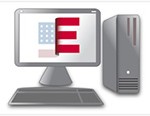Where Running Your Business and the Immigration Debate Could Collide

E-Verify’s purpose is simple: that is, to give you an easy way to find out whether the information job applicants and employees record on their I-9 forms is consistent with Social Security Administration records. It emerged early in the last decade after a series of expanding pilot programs.
What is the Proposed Legal Workforce Act?
The proposed Legal Workforce Act (HR 1147) would repeal the current paper-based I-9 system and replace it with a completely electronic work eligibility check. The legislation phases in mandatory E-Verify participation for new hires in six-month increments beginning on the date of enactment.
Within six months of enactment, businesses having more than 10,000 employees would be required to use E-Verify. Within 12 months of enactment, businesses having 500 to 9,999 employees would be required to do so, and after eighteen months, employers with 20 to 499 employees would have to fall into line. Finally, after two years the smallest group of employers — those with up to 19 employees, would be covered by the law.
Employers would be allowed to use E-Verify to check the work eligibility of their current employees, as long as they do so in a nondiscriminatory manner and include all employees who are in the same geographic location or in the same job category.
Additional highlights of the proposed measure:
- Duplicative state laws mandating E-Verify use would be preempted, and states would play a prominent role in enforcing the law. For example, states and localities would retain the ability to condition business licenses on the requirement that the employer use E-Verify “in good faith” under federal law.
- The bill allows individuals to “lock” their Social Security numbers so that the number can’t be used by another person to get a job.
- Employers would be granted a safe harbor from prosecution if they use the E-Verify program in good faith, and through no fault of their own, receive an incorrect eligibility confirmation.
- The bill raises penalties on employers who knowingly hire illegal immigrants in violation of the requirements of the bill. The bill also creates a penalty for individuals (employees or employers) who knowingly submit false information to the E-Verify system.
Could this proposal become law? Stay tuned. We’ll keep you up-to-date on developments.
This is the sequence of steps involved in using the Web-based system:
1. Basic employee (or prospective employee) data is entered into the system and submitted.
2. The system either generates a confirmation of the consistency of the data or a temporary non-confirmation, or TNC.
3. The process is over with a confirmation. But a TNC requires further action: The job applicant/employee either calls:
- the Social Security Administration to appeal the TNC if the issue is an inconsistency on the Social Security number,
- or U.S. Citizenship and Immigration Services (USCIS) for a “noncitizen immigration document mismatch.” Sometimes, the applicant will need to deal with both agencies.
4. Typically, the appeals process leads to a lifting of the TNC. If the job applicant/employee fails to appeal the TNC within eight days, the system generates a “final non-confirmation” report, and the individual must either be terminated or turned down for the job.
Mandated Use
Beginning in 2007, the I-9 information of all prospective federal employees had to be run through the system. Two years later, the same requirement was extended to federal contractors. And today, according to the immigration control advocacy organization, NumbersUSA, four states – Arizona, Mississippi, Alabama and South Carolina – require all employers to use E-Verify. Thirteen additional states require use of the system by state agencies (and in some cases, contractors to those agencies).
California and Illinois, in contrast, have laws limiting employers’ ability to use E-Verify.
According to USCIS, over half a million employers use the system today at more than 1.4 million hiring sites. The agency also claims that E-Verify is “one of the federal government’s highest-rated services for customer satisfaction.”
If it’s so wonderful, why doesn’t everybody use it? And why have proposals in congress to make its use mandatory for all employers been defeated in the past? Some employers consider it a costly, added administrative burden they’d like to avoid if possible.
Faulty Information
Some immigration advocacy groups believe E-Verify can lead to difficulties for many legal immigrants when the system sounds the alarm inappropriately due to a system glitch. Some organizations have raised concerns that people could lose jobs due to system errors. In other words, there could be an E-Verify determination that a legal resident was not authorized to work in the United States.
In addition, some industries, such as agriculture, oppose the proposed legislation on its own. The American Farm Bureau Federation, for example, says that the proposed law “would be devastating to agriculture,” if it was passed without other changes such as a new guest worker program.
On the other hand, several large business groups, including the National Restaurant Association, the National Association of Homebuilders, and the International Franchise Association, have endorsed proposed legislation that would repeal the current paper-based I-9 system and require the use of E-Verify.
The restaurant group, for example, praised the proposed measure as a good alternative to “an existing patchwork of state and local rules that are unworkable for restaurateurs and the employer community at large … a standardized E-Verify system will strike the right balance with the employer community and provide clarity and certainty in their hiring decisions.”
The proposed legislation (called the Legal Workforce Act) cleared the House Judiciary Committee in early March. The measure would not make E-Verify immediately universal, but instead phase in compliance (see the right-hand box). A similar measure is pending in the U.S. Senate.
The political winds whipping around the immigration debate in Washington are unpredictable, and will only intensify as the next presidential election draws nearer. Meanwhile, employers can decide for themselves whether E-Verify is time-saving and provides peace of mind, or is something else.




